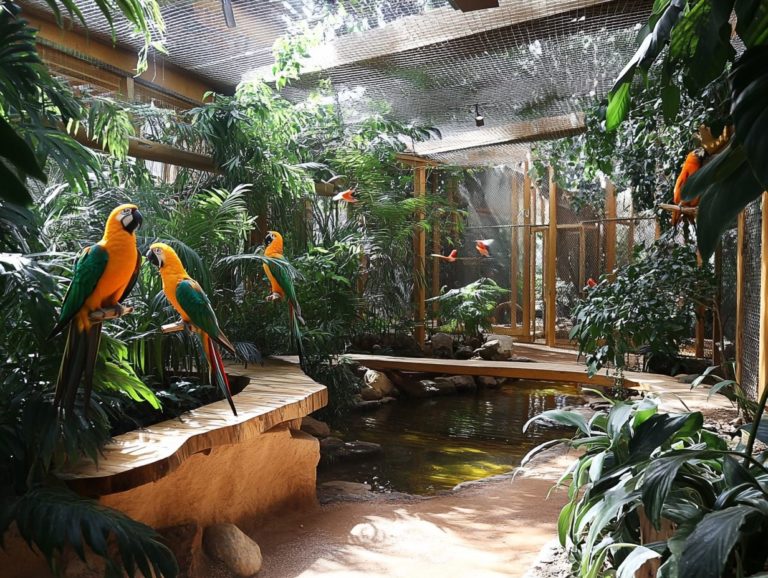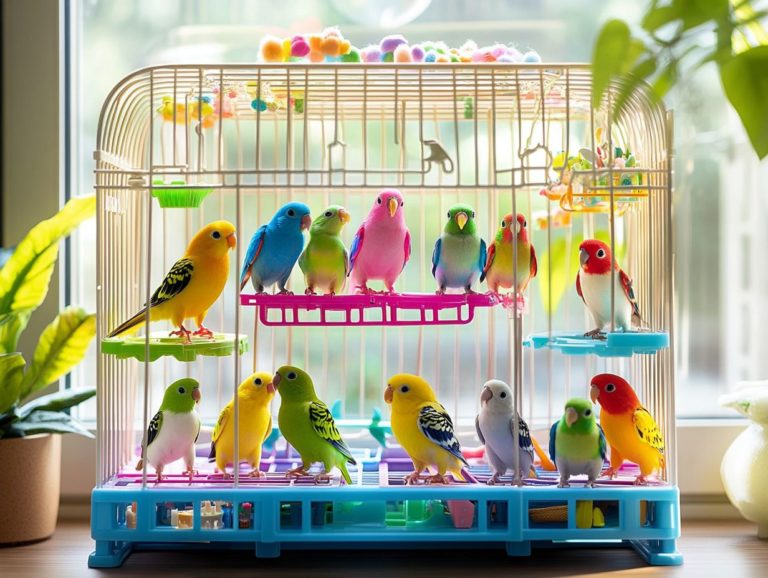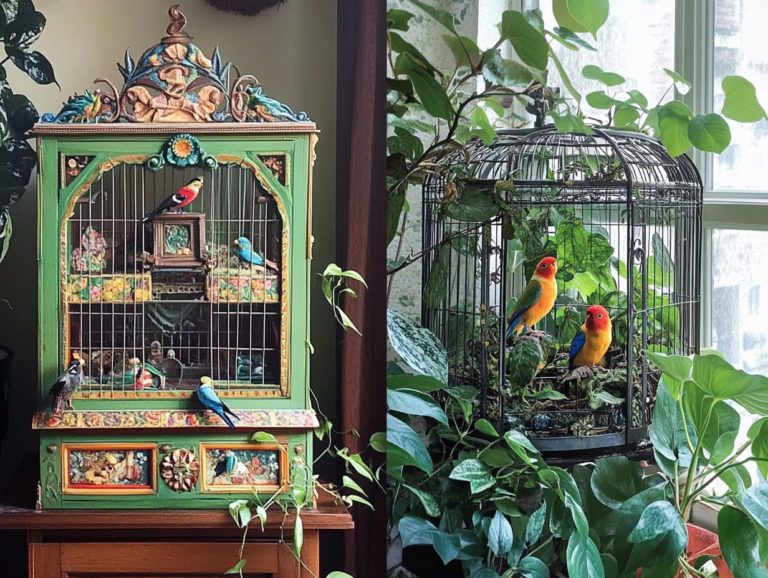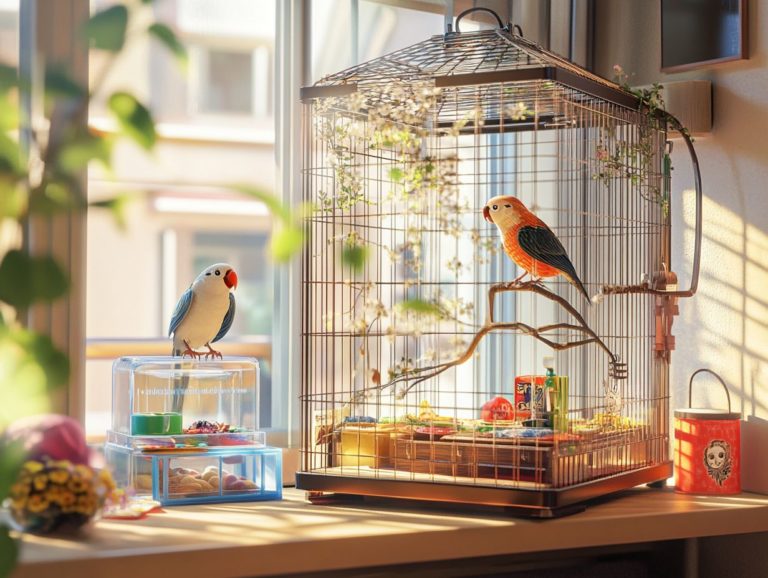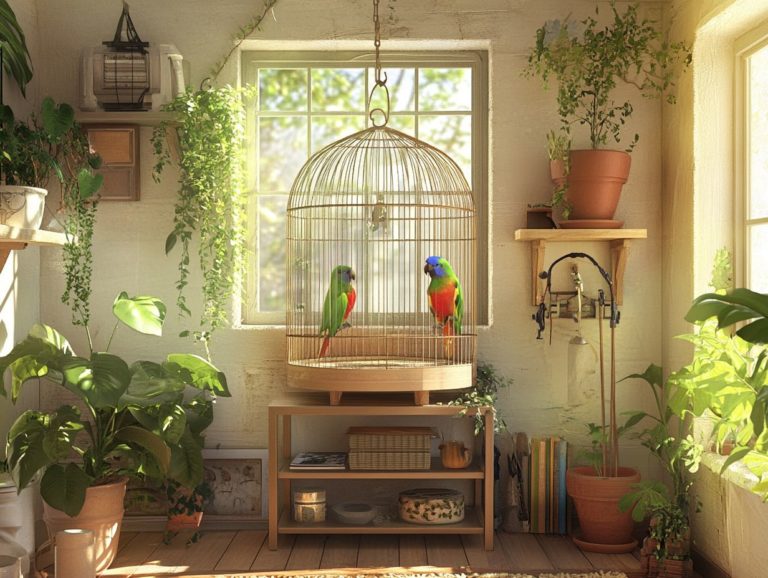Best Plants to Include in Your Bird’s Cage
Creating a vibrant and healthy environment for your feathered companion transcends merely providing food and toys. Adding plants to your bird’s cage unlocks numerous benefits enhancing physical health and offering essential mental stimulation.
Dive right in and discover the best plants for your feathered friend, understand how they contribute to your bird’s well-being, and gather tips for their proper care. Transform your bird’s habitat into a lush oasis that fosters happiness and health.
Embark on this colorful journey of discovery!
Contents
- Key Takeaways:
- 1. Choosing the Right Plants for Your Bird’s Cage
- 2. Benefits of Having Plants in Your Bird’s Cage
- 3. Non-Toxic Plants for Your Bird’s Cage
- 4. How to Properly Care for Plants in Your Bird’s Cage
- 5. Creating a Natural Environment for Your Bird
- 6. Plants That Help with Your Bird’s Digestion
- 7. Plants That Provide Mental Stimulation for Your Bird
- 8. Plants That Help with Your Bird’s Respiratory Health
- 9. Plants That Add Color and Aesthetics to Your Bird’s Cage
- 10. Plants That Help with Your Bird’s Sleep
- 11. Plants That Provide Shade and Shelter for Your Bird
- 12. Plants That Help with Your Bird’s Immune System
- 13. Plants That Help with Your Bird’s Beak and Nail Maintenance
- 14. Plants That Help with Your Bird’s Emotional Well-Being
- 15. How to Introduce Plants to Your Bird’s Cage Safely
- Frequently Asked Questions
- What are the best plants to include in my bird’s cage?
- Can I include any type of plant in my bird’s cage?
- How do I know if a plant is safe for my bird’s cage?
- Should I include live or fake plants in my bird’s cage?
- How often should I replace the plants in my bird’s cage?
- Can my bird eat the plants in its cage?
Key Takeaways:
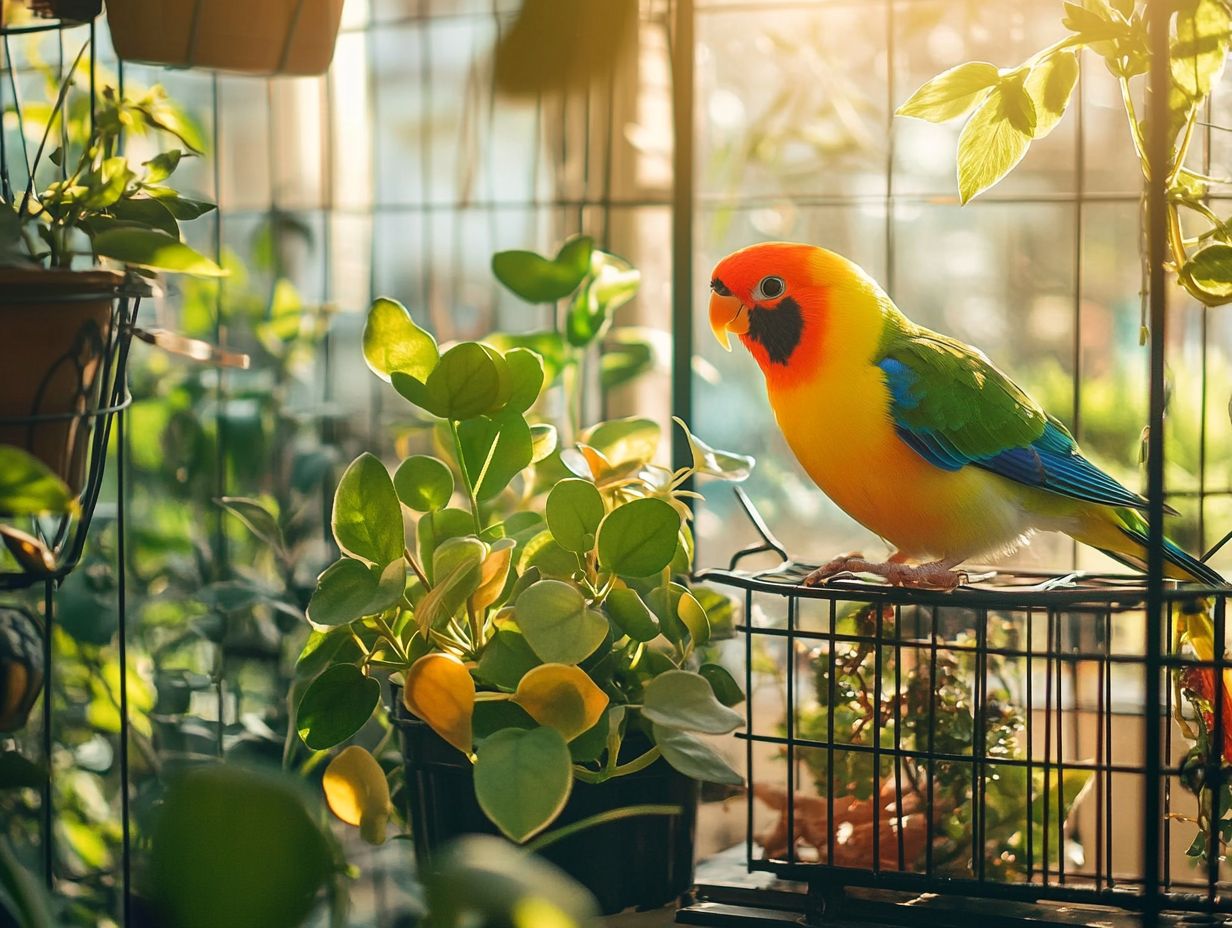
- Plants improve your bird’s digestion and respiratory health.
- Non-toxic plants add color and beauty while promoting better sleep and a stronger immune system.
- Choosing and caring for the right plants ensures a safe environment for your bird.
1. Choosing the Right Plants for Your Bird’s Cage
Selecting the right plants for your bird’s cage is vital for your pet bird’s health and the overall aesthetics of their habitat. Incorporating the best herbs for pet birds enhances their well-being and helps you avoid toxic varieties that could harm them.
Birds thrive in environments mimicking their natural habitats, and adding plants can greatly improve their quality of life. Among safe options, the spider plant stands out with its impressive air-purifying abilities, while the rubber tree provides lush greenery for exploration. Mint adds a refreshing fragrance and acts as a natural foraging tool, encouraging delightful behaviors.
Focus on safety and creating a vibrant aesthetic that complements your birdcage planter’s design. This thoughtful approach creates a harmonious blend of beauty and well-being for your feathered companions.
2. Benefits of Having Plants in Your Bird’s Cage
Adding plants to your bird’s cage elevates their habitat, offering benefits like enhanced mental stimulation and a more natural environment. These factors encourage healthy behaviors that are vital for your bird’s overall well-being.
Plants beautify the space and provide ways for your birds to find food naturally, prompting them to engage in instinctual activities that boost their physical health. However, it’s crucial to be aware of which plants are safe for your feathered friends. For instance, while varieties like spider plants and pothos thrive indoors and contribute to a vibrant atmosphere, some plants can be harmful. Check out the top 10 indoor cage plants toxic to birds to ensure a safe environment for your pets.
This infusion of greenery amplifies visual appeal and instills a sense of security and enrichment, ultimately leading to happier, more content birds.
3. Non-Toxic Plants for Your Bird’s Cage
Choosing non-toxic plants for your bird s cage is essential for a safe living environment. Many common household plants can be hazardous to pet birds, so it s vital to identify safe options like spider plants, basil, and chamomile.
Consider adding parlor palms, which enhance air quality and bring delightful greenery. Spider plants provide playful foliage for exploration. Herbs like oregano and mint stimulate your bird’s appetite and offer mental enrichment.
Understanding plant toxicity is crucial; toxic varieties are plants that can harm your pets. Always consult a clear list of non-toxic plants before introducing greenery into the cage, ensuring your feathered friends thrive in a safe and stimulating habitat.
4. How to Properly Care for Plants in Your Bird’s Cage
Caring for the plants in your bird’s cage is crucial for promoting growth and ensuring a vibrant environment for your feathered friends. This involves regular maintenance such as watering, trimming leaves, and using organic soil to optimize both aesthetics and health benefits.
To maintain your plants effectively, establish a consistent watering schedule. Let the top layer of soil dry out between waterings to prevent a condition where plant roots decay due to excessive moisture, known as root rot.
Understanding the light requirements is important as well. Position the pots where they can bask in indirect sunlight to avoid scorching.
Don t forget to regularly trim away dead or yellow leaves. This enhances the plant’s appearance and encourages fresh growth. Using organic soil creates nutrient-rich conditions that foster vibrant plants, improving air quality and providing your birds with essential natural enrichment key elements in cultivating a thriving habitat.
5. Creating a Natural Environment for Your Bird
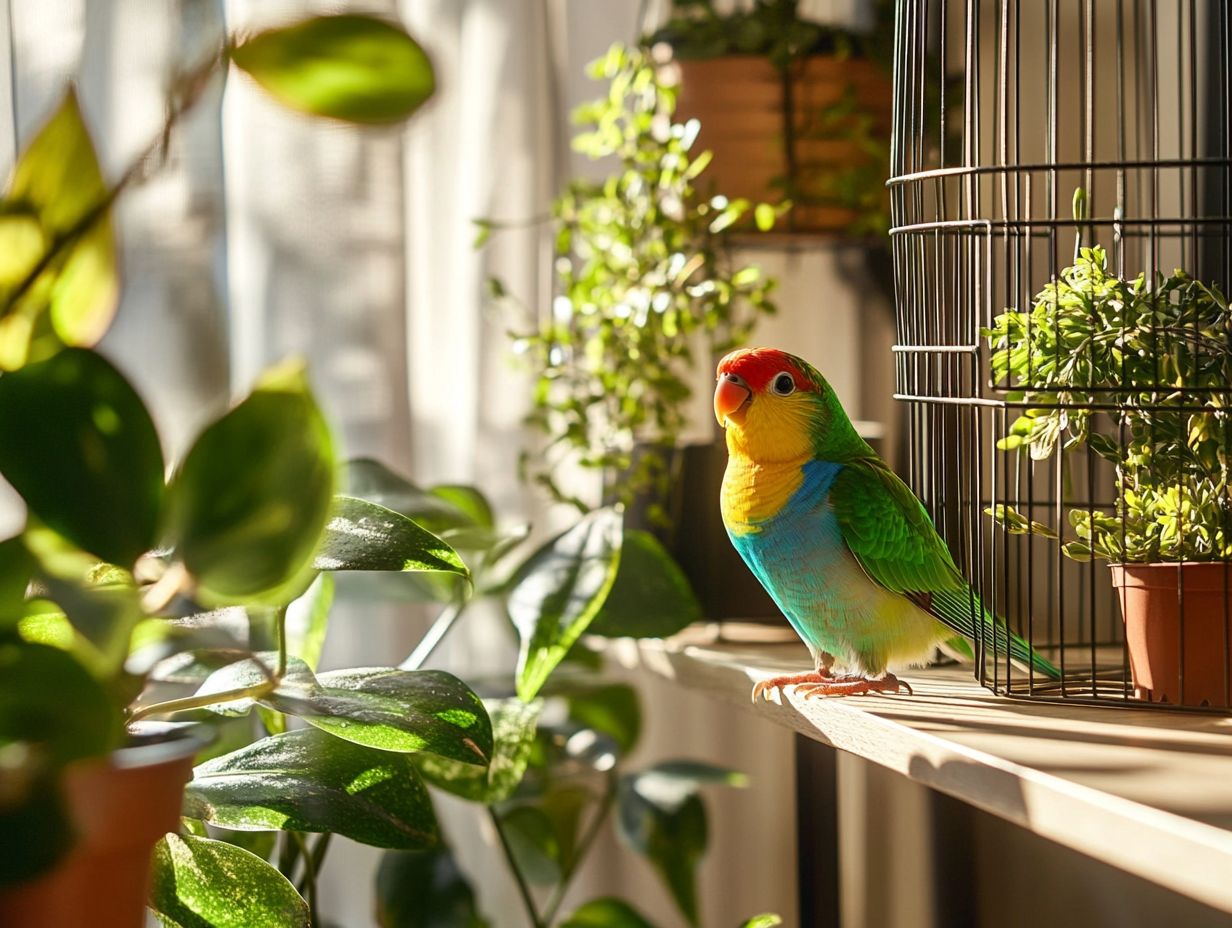
Creating a natural environment for your bird enhances its habitat and fosters well-being and happiness. Thoughtfully combining plants and making safe choices allows your pet bird to engage in natural behaviors that mirror its wild counterparts.
Incorporating specific plant species that replicate your bird s native surroundings can significantly boost its emotional health. For example, varied heights and textures with an assortment of foliage provide climbing opportunities and hiding spots, encouraging exploration and play.
Consider integrating non-toxic plants like spider plants or pothos, which offer safe foliage for your bird to interact with. Employ indoor gardening strategies focusing on varied lighting and humidity levels to create a more authentic atmosphere.
Utilizing these approaches enriches your bird’s environment and promotes instincts that lead to healthier, happier lives for your avian companions. Try adding these plants today for a happier bird!
6. Plants That Help with Your Bird’s Digestion
Certain plants, especially herb varieties and safe vegetables like dandelion and kale, can significantly enhance your bird’s digestion, offering essential nutrients that contribute to overall health and well-being.
Integrating these herbs and vegetables into your bird’s diet creates a vibrant, nutritious feeding routine that promotes optimal digestive health. To introduce these wholesome options, start by adding small amounts of finely chopped dandelion leaves or steamed kale to their regular meals. This gradual approach allows your bird to adapt to new flavors and textures without feeling overwhelmed.
This method enriches their diet and introduces variety, essential for preventing dietary boredom. Keep an eye on any changes in stool or behavior for valuable insights into how well your bird adjusts to these delightful additions, ensuring they enjoy a balanced and beneficial diet.
7. Plants That Provide Mental Stimulation for Your Bird
Integrating plants that stimulate your bird s mind into their cage environment can significantly enhance their mental activity and overall quality of life. This creates essential opportunities for interaction and exploration, crucial for their development.
Birds thrive when surrounded by a variety of stimulating plants, such as bamboo, millet, and certain herbs like basil and parsley. These plants provide visual appeal and encourage foraging behavior, allowing your feathered friends to peck, explore, and interact in ways that mimic their natural habits.
Including safe plants like spider plants or pothos is a great idea as they add a touch of greenery without posing any risk. By incorporating these interactive elements, you can craft an enriching habitat that supports your birds’ mental agility, ultimately leading to healthier and happier companions.
8. Plants That Help with Your Bird’s Respiratory Health
Certain plants can play a vital role in enhancing your bird’s respiratory health by improving air quality and enriching their living space. It s essential for bird owners to choose safe plants that foster a clean and breathable environment.
Among the numerous options available, some standout choices include the Spider Plant, Peace Lily, and Bamboo Palm. These plants are celebrated for their ability to clean the air. They filter out toxins like formaldehyde and benzene while also releasing oxygen, cultivating a healthier atmosphere.
When selecting indoor plants, it’s crucial to ensure they are non-toxic to birds. Conducting thorough research will guide you toward safe options. By incorporating these plants into your bird’s habitat, you beautify the space and enhance their overall well-being, supporting respiratory health and promoting a vibrant, lively environment.
9. Plants That Add Color and Aesthetics to Your Bird’s Cage
Incorporating vibrant and aesthetically pleasing plants into your bird’s cage can truly transform the environment into a lively habitat. This not only enriches your pet’s living space but also ensures that your selections are safe plants for pet birds to promote their health.
Carefully chosen plants serve as a visually appealing backdrop for both you and your bird, successfully mimicking the natural surroundings that many species thrive in.
Consider options like spider plants, parlor palms, and bamboo; they are not only strikingly green but also safe for your avian friends. By integrating these plants, you foster a cozy atmosphere that allows both you and your bird to feel a stronger connection to nature.
This enhances your daily interactions and experiences together. You ll love how these plants beautify the space!
10. Plants That Help with Your Bird’s Sleep
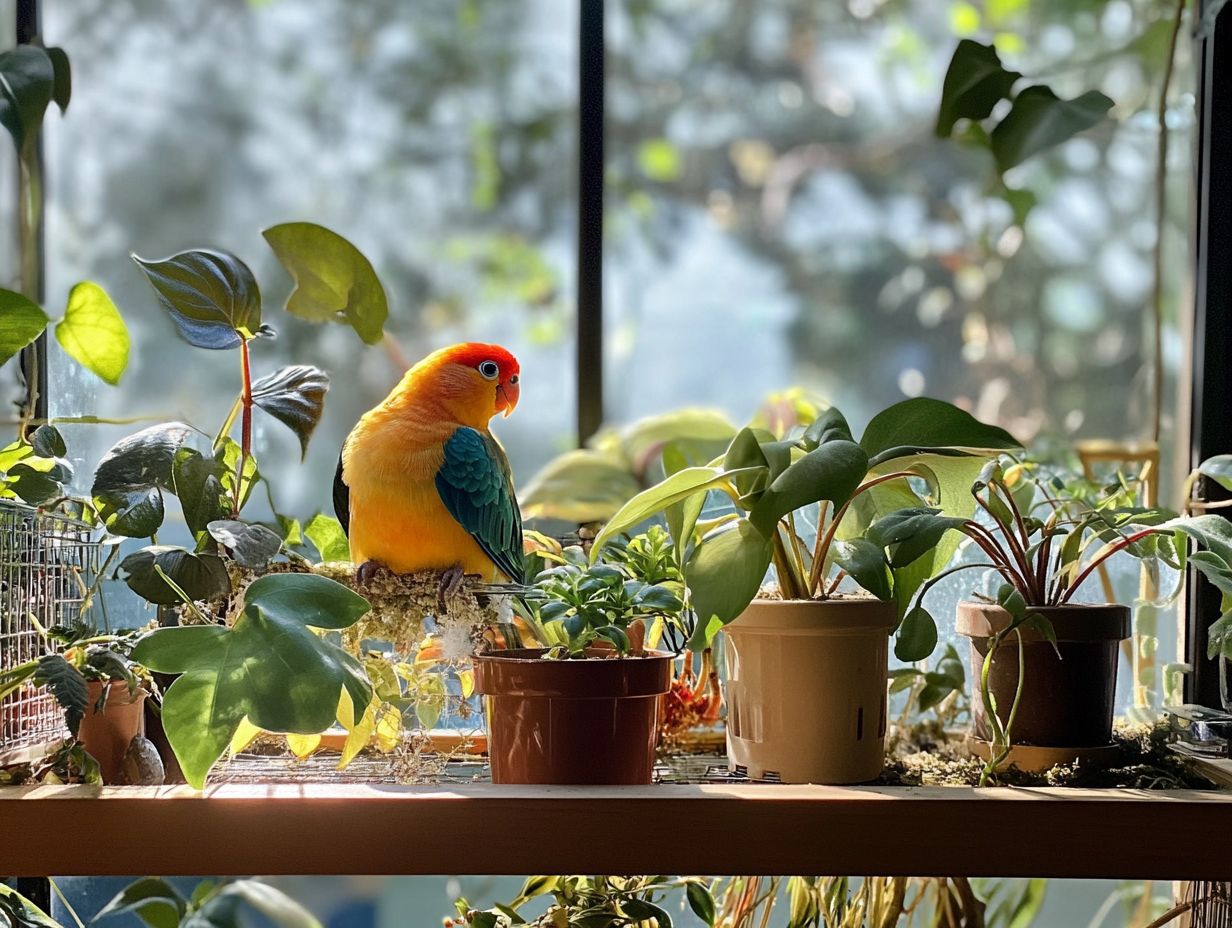
Incorporating calming plants into your bird’s cage can significantly enhance your pet’s sleep quality. Certain bird-friendly plants create a serene environment that fosters relaxation and peace during those nighttime hours.
Selecting the right greenery is crucial for elevating the overall mood of your avian habitat. For example, species like lavender and chamomile are known for their soothing properties. They promote tranquility and reduce stress levels in birds.
Low-light plants, such as peace lilies, can also contribute to a calming atmosphere, especially when positioned thoughtfully within the cage. These plants beautify the space while encouraging restful sleep and transforming the cage into a comforting retreat for your feathered friends.
11. Plants That Provide Shade and Shelter for Your Bird
Selecting plants that provide shade and shelter in your bird’s cage enhances their habitat. This creates a secure and comfortable environment.
This allows your feathered friends to retreat to shaded areas that closely mimic their natural surroundings while ensuring the plants are safe for them.
Incorporating such elements is vital for visual appeal and the overall well-being of your avian companions. Consider species like spider plants, pothos, and ferns. They offer necessary cover, reducing stress and creating inviting retreats for your pet.
These plants help maintain humidity levels, further enhancing your birds’ comfort. They foster a sense of security, enabling your pet birds to explore and interact with their surroundings more freely.
This relaxed atmosphere is crucial for their mental stimulation and overall happiness. Try adding these plants today for a healthier and happier bird!
12. Plants That Help with Your Bird’s Immune System
Certain plants can provide substantial support for your bird’s immune system. These plants are particularly rich in nutritional benefits, such as safe herbs and nutritional herbs.
Basil, oregano, and parsley are rich in vitamins and antioxidants. They play a crucial role in boosting your bird’s overall well-being.
Incorporating these plants into your bird’s diet not only adds delightful variety but also introduces natural compounds that help fend off infections. For example, oregano fights germs, while parsley is high in vitamin K, vital for optimal immune function.
By sprinkling a touch of these fresh herbal plants onto your bird’s food or presenting them as treats, you’re contributing to a balanced diet that fosters resilience and vitality.
13. Plants That Help with Your Bird’s Beak and Nail Maintenance
Certain plants can significantly aid in maintaining your bird’s beak and nails. They offer textures and surfaces that encourage healthy wear and tear, crucial for their overall well-being.
Consider incorporating untreated branches or specific types of palm leaves into their space. These additions introduce a delightful variety of textures that promote natural grooming behaviors.
Birds instinctively seek out rough surfaces to manage the growth of their beaks and nails. It s essential to integrate such plants into their living environment.
These natural elements also play a vital role in reducing the risk of overgrowth and potential health issues. By cultivating a more engaging space filled with safe greenery, you support these important grooming habits, ensuring your feathered companions remain both healthy and happy.
14. Plants That Help with Your Bird’s Emotional Well-Being
Incorporating plants that promote emotional well-being into your bird’s cage can greatly improve their quality of life. These plants provide enrichment opportunities that foster happiness and alleviate stress.
These lush additions create a vibrant and inviting atmosphere, stimulating natural behaviors like foraging and exploration. Safe plant varieties, such as spider plants and parlor palms, not only elevate the aesthetic appeal but also engage your bird s mind.
By interacting with safe greenery that encourages climbing and chewing, your bird will beat boredom, positively influencing their mood and overall emotional state.
Choose vibrant, bird-friendly plants to create a lively home! They not only beautify the space but boost your bird’s happiness and psychological health, transforming their home into a true sanctuary.
15. How to Introduce Plants to Your Bird’s Cage Safely
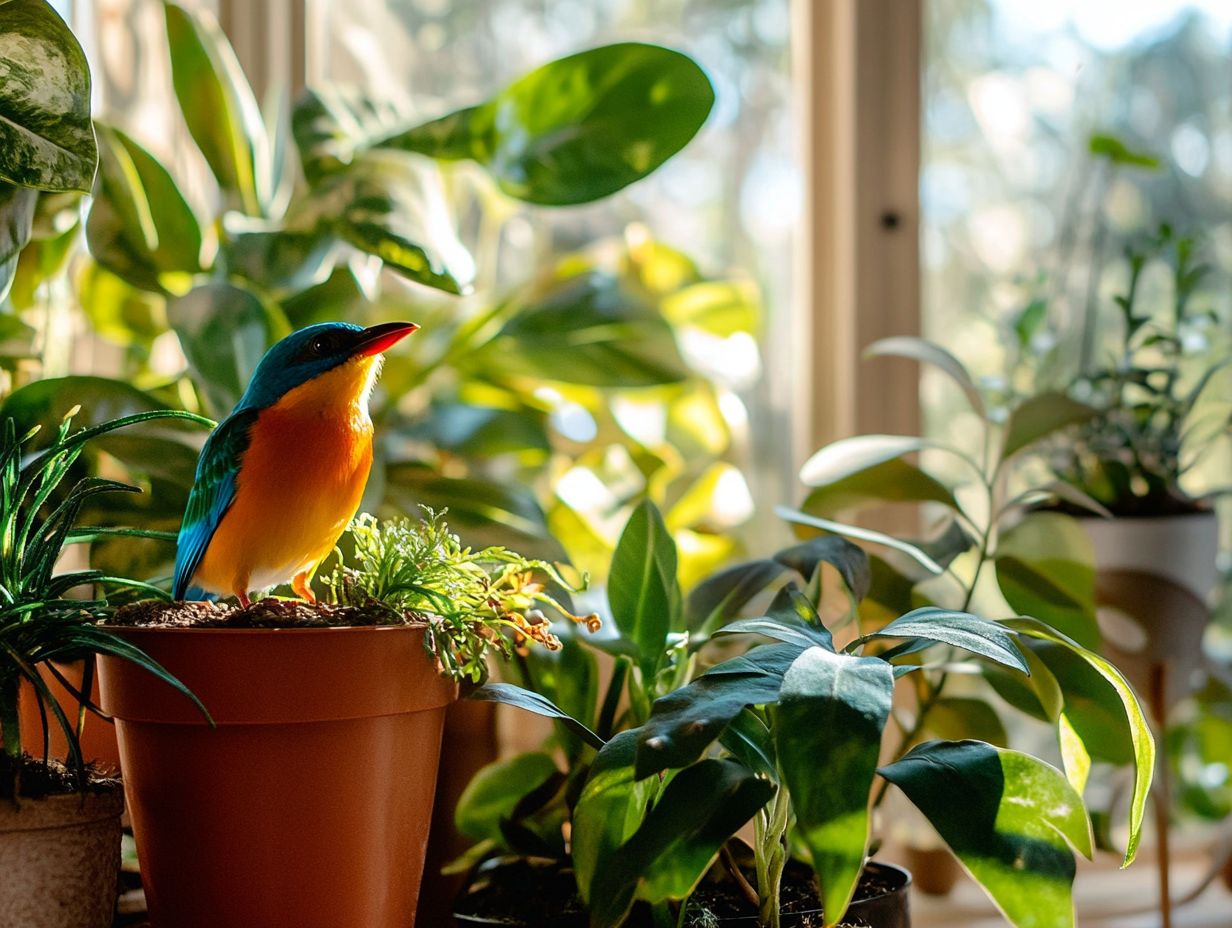
Introducing plants to your bird’s cage is essential for their health and well-being, but it requires careful thought to ensure you’re making safe choices. Gradual acclimatization is key to preventing stress or negative reactions.
Start by researching which plants are non-toxic and suitable for an avian environment. Once you ve selected safe options, introduce them slowly.
Consider placing the plant outside the cage for a few days, allowing your bird to observe it from a distance. This simple step helps minimize stress, letting your feathered friend adjust to any new scents or sights.
During this adjustment period, keep a close watch on your bird for any unusual behaviors or reactions. Pay attention to their eating habits and activity levels, as any changes could indicate discomfort.
Understanding plant safety goes beyond just ensuring the plants are non-toxic; it also involves recognizing how they might influence the overall ambiance of your bird s habitat. This awareness will enable you to create a balanced and healthy environment for your avian companion.
Frequently Asked Questions
What are the best plants to include in my bird’s cage?
Some of the best plants for your bird’s cage are safe and non-toxic options like spider plants, African violets, and Boston ferns. These plants not only enhance your bird s environment but also purify the air.
Can I include any type of plant in my bird’s cage?
You must only choose non-toxic, bird-safe plants for your bird’s cage. Some plants can harm your feathered friend, so always research before adding new ones.
How do I know if a plant is safe for my bird’s cage?
Many online resources list bird-safe plants. You can also ask a veterinarian or a seasoned bird owner for trustworthy recommendations. Always double-check before introducing a new plant.
Should I include live or fake plants in my bird’s cage?
While fake plants are low maintenance, live ones boost air quality and create a natural setting. Just ensure they re bird-safe, and monitor your bird to prevent nibbling on harmful plants.
How often should I replace the plants in my bird’s cage?
Regularly check for and replace any dying plants in your bird’s cage. This helps keep their home healthy and interesting. Rotating plants can add variety and excitement!
Can my bird eat the plants in its cage?
Some plants are safe for your bird to nibble on in moderation. However, it’s better to create a separate area for foraging and provide bird-safe treats instead of letting them munch on cage plants.


